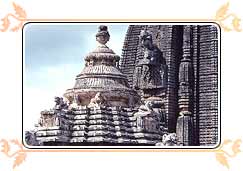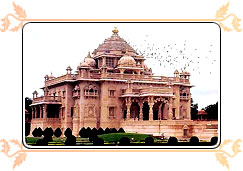Bhubaneswar
Location : Orissa
Significance : Capital of Orissa
Related Links : Lingaraja Temple, Muktesvara Temple
The ancient capital of the Kalinga empire, and now the capital of Orissa, Bhubaneswar's history goes back over 2000 years. "Bhubaneshwar" means the "abode of God" or "master of the universe" and it was also, once known as the 'Cathedral of the East', on account of the large number of shrines. At one time, the Bindu Sagar tank was bordered by over 7000 temples. Of these, 500 still survive, all built in the extravagant Oriya style. It is of these temples, that the great poet, Rabindranath Tagore had once said - 'At all places where the eye rests, and also at places where the eye does not rest, the busy chisel of the artist has worked incessantly. The abode of god has been enveloped by a variety of figures depicting the good and the evil, the great as well as the insignificant, the daily occurrences of human life....'
 The People
The People
Since primeval days various people have inhabited the land of Orissa. The initial homesteaders of Orissa were primitive hill tribes like Saora or Sabar from the Mahabharata days. Most of the tribal people have been induced by Hindus and have embraced Hindu bearings, customs and ceremonies. Bonda Parajas of Koraput district is the foremost example of these tribes.
These tribes are not at all touched by neoteric edification and thus the tribal traditions have been left flawless through the ages. Each tribal group has its own distinct language, culture, religion and social customs.
Orissa is the state with 3rd highest centering of tribals with almost 62 tribes existing in the city today. The tribal population is located mainly in the Korapur, Phulbani, Sundargarh and Mayurbhanj districts.
The regional language of the city is Oriya belonging to Aryan family of languages and is closely associated to Assamese, Bengali and Maithili.
Culture of Orrisa
Bhubaneswar holds an opulent artistic tradition, which enjoyed reform custom from the temples. Land of adroit artists and craftsmen, still retain their nativity and continuously trying to purge it to suit a changing milieu.
The rich Orissa culture is also depicted in its glowing traditional Odissi Dance. The intricate and elegant hand, feet and facial movements are all the additional charms of the dance. The dance features Jayadev's "Gita Govinda" the 12th century epic that deals with stories representing Krishna's love for Radha expressing both divine and passionate emotions in the dance drama. In olden days the dance was a form of devotion and was performed in the temples as a tribal offering to the Gods.
"Chaitghoda", the traditional dance of fishermen shows rich cultural heritage and is performed by using a dummy horse depicting the battle drama called "Pari ka Nritya".
Other folk and tribal dances include Danda Nata a dance drama showing acrobatic charms in which dancers perform balancing acts on bamboo stilts. Chhah-masked dance is performed during festivals.
Pilgriamage Attractions of Bhuvaneshwar Temples
Most of the temples are located near the Bindu-sarovara Tank, which is about two km south of the city center. Lingaraja and Vital Duel Temples are located west of the tank. Parasumaresvara and Muktesvara temples are east of the tank. The Rajrani and Brahmesvara Temples are a ten to fifteen-minutes walk east of the Muktesvara Temple.
# Lingaraja Temple (11th century)
The presiding deity is the svayambhu linga, Hari-Hara Linga, which is half Siva and half Vishnu. He is also named Tribhuvaneswara, the Lord of the three worlds. The linga of Lingaraja, or Krittivasas, is an uncarved block of granite 8 feet in diameter raised 8 inches above the ground. The Siva linga is bathed daily with water, milk and bhang. There are many other deities in the temple. In the northeast corner of the temple there is a deity of Parvati.
# Muktesvara Temple
o Built in the 10th century, this small elegant temple has been described as the most exquisitely ornamented temple in Bhubaneswar. It has an 11m (35 feet) high tower. The sandstone carvings are the most notable feature of this temple. It is also known for its ornamental gateway, carved dwarves, and intricate motif carvings of a smiling lion, adorned with beaded tassels in its mouth. Muktesvara means the Lord who bestows freedom through yoga. The Siddeswara Temple is on the same grounds and has a Ganesh deity.
The small Marichi Kund, between the Mukesvara Temple and the road, is known to cure infertility in women. It is a pleasant place to sit for awhile.
o Parasurameswara Temple
This temple is the oldest Siva temple in Bhubaneswar, built in the late 7th century. There are many intricate carvings on this temple. It is close to the Bhubaneswar to Puri road, on the east side of Bindu-sarovara, northeast of the Lingaraja temple. It is the best preserved and most impressive of Bhubaneswar's early temples. It has interesting carvings of elephant and horse processions and intricately carved windows. In the corner of the countryard is the Sahasra-linga, which is 1000 small lingas joined together.
o Raj Rani Temple
The Raj Rani Temple (11th century), which is surrounded by a nice garden is no longer used for worship. This temple was dedicated to Lord Brahma and is known for its well-carved tower. It is about a km east of the main road. It is one of the later Bhubaneswar temples.
Around the temple are carvings of the eight dikpalas (temple guards), who protect the temple from the different directions. They are eight important demigods. They are Indra (east) the head of the demigods, Agni (southeast) god of fire, Yamaraja (south) god of death, Nirritti (southwest), Varuna(west) god of water, Vayu (northwest) god of air, Kubera(north) god of wealth, and Isana (northeast).
o Brahmeshwara Temple
This temple was built around 1050 and is a Siva-linga temple with active worship. It is known for its intricately carved sculptures. The main tower is over 18m high. It is about a km east of the main road, a good walk from the Raj Rani Temple. On the north wall of the porch is a carving of Laksmi.
o Vaital Deul Temple
This interesting 8th century temple is dedicated to Chamunda (Kali). She wears a necklace of skulls and is shown as the eight-armed slayer of the buffalo demon. Her necklace of skulls and the corpse she is sitting on are usually hidden by her robes. In her arms she holds a snake, a bow, a shield, a trident, a thunderbolt and an arrow with which she is piercing the neck of the demon, thus displaying the most terrifying aspect of the goddess Kali.
This temple is close to Bindu Sagar, and it has some intricate exterior carvings. To get a good view of the temple's interior, a flashlight (torch) is needed.
o ISKCON Temple
The beautifully built ISKCON temple (413-517) is located on National Highway No.5, Nayapali. The Deities in the temple are Krishna Balaram, Jagannatha, Baladeva and Subhadra, and Gaura-Nitai. There is also a new Radha-Krishna temple. Srila Prabhupada laid the cornerstone for this temple in February 1977, and it was finished in 1992.
There is a small guesthouse here with rooms that have attached bathrooms. These rooms are not always available, but they are quite nice if you can get one. To stay here you have to follow the ashram rules. There is a fairly basic vegetarian restaurant here.
Festivals
The end of January is the time when the Tribal Fair comes around. February to March, Shivaratri is held at the Lingaraj Temple, Hakateswar Temple Atri and throughout Orissa. Magha Saptami is held at Khandagiri outside Bhubaneshwar.
At Ashokashtami, during April/May, the idol of Lord Lingaraja is taken out in procession, part of a chariot festival. Panashankanti (Fire-walking) takes place in various areas on the first day of Baisakh. In June/July, the impressive Rath Yatra takes place at Puri, Baripada and other parts of the state. Kali Puja, in October/November, the city is lit with lamps. Bali Yatra in October/November, a fair is held on the banks of the Mahanadi river in Cuttack.
How to Get
There On the National Highway linking Calcutta (480 km) and Madras (1225 km). Air links to Delhi, Calcutta, Hyderabad and Nagpur. Rail links to Calcutta, Madras, Delhi (1745 km), Bombay(1691 km).




























 The People
The People  truth of being, the sages and profound thinkers of early India have helped in solving the problems of the origin, the nature and the destiny of man and the universe. Since then temple has acted as the entrance of self-realization and God. Akshardham is not just a temple, but a place of education, entertainment and enlightenment. There are 73 richly patterned and 63 partially carved pillars.
truth of being, the sages and profound thinkers of early India have helped in solving the problems of the origin, the nature and the destiny of man and the universe. Since then temple has acted as the entrance of self-realization and God. Akshardham is not just a temple, but a place of education, entertainment and enlightenment. There are 73 richly patterned and 63 partially carved pillars.

